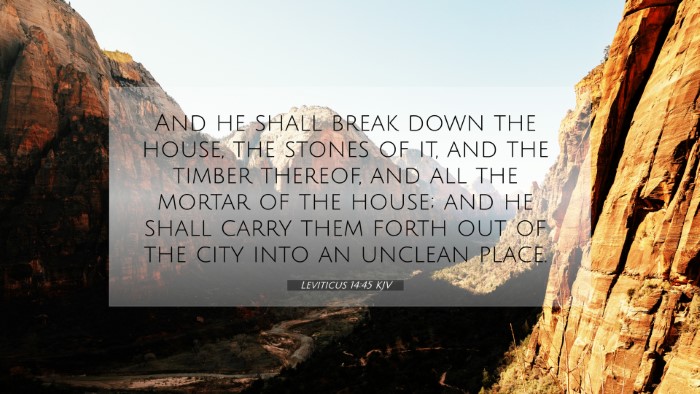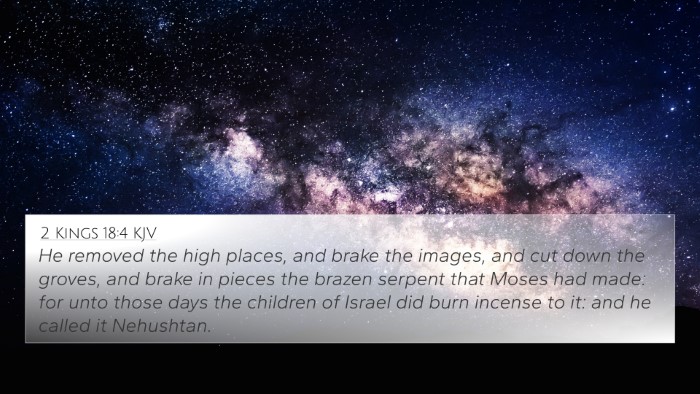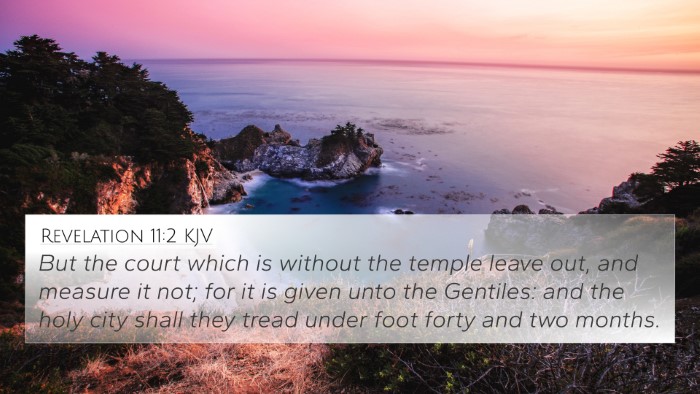Understanding Leviticus 14:45
Leviticus 14:45 states: "And he shall break down the house, the stones of it, and the timber thereof, and all the morter of the house; and he shall carry them forth out of the city unto an unclean place."
This verse is situated within a larger context concerning the laws of cleanliness and purification regarding leprosy and other diseases. In particular, it discusses the procedure for dealing with a house that has been affected by a form of plague—commonly interpreted as mold or mildew.
Commentary Insights
The following insights from renowned biblical commentaries shed light on the meaning of this verse:
- Matthew Henry: He emphasizes that the severe action of tearing down the house signifies the seriousness of the contamination. Henry notes that it serves as a physical representation of spiritual corruption and the necessity of purification, underscoring the importance of spiritual cleanliness in the life of the community.
- Albert Barnes: Barnes highlights that the destruction of the house is a reflection of God's holiness. He points out that while God desires for His people to be cleansed and whole, there are instances where complete removal is necessary to restore purity. This speaks to the broader theme of sin and the drastic measures sometimes required to remove its influence.
- Adam Clarke: Clarke elaborates on the practice of demolishing the house, indicating the potential implications for communal health. He also reflects on the broader significance of this act, suggesting that it serves to protect the community from the potential spread of disease. Clarke illustrates how this physical action corresponds to the need for moral and spiritual vigilance in one's life.
Thematic Connections
This verse not only offers insights into ancient Israelite practices but also resonates with numerous themes throughout the Scripture, highlighting the necessity of purification, the ramifications of sin, and the call for holiness among God's people.
- Cross Reference 1: Numbers 5:2-3 - This passage discusses the separation of unclean individuals from the camp of Israel, establishing a theme of purification.
- Cross Reference 2: 2 Corinthians 6:17 - New Testament validation of separating from unclean things, emphasizing holiness.
- Cross Reference 3: Hebrews 12:14 - Calls believers to pursue peace and holiness, paralleling the purifying actions in Leviticus.
- Cross Reference 4: Matthew 7:5 - Jesus warns against hypocrisy, urging individuals to cleanse their own lives, which correlates to the need for external cleansing in Leviticus.
- Cross Reference 5: James 4:8 - “Cleanse your hands, you sinners; and purify your hearts, you double-minded!” aligns with the call for spiritual cleanliness.
- Cross Reference 6: Revelation 21:27 - Speaks of nothing unclean entering the heavenly city, which reinforces the need for purification.
- Cross Reference 7: Ephesians 5:27 - Paul speaks of presenting the Church as a pure bride, resonating with the theme of being cleansed from impurities.
Connecting the Old and New Testaments
The act of breaking down the contaminated house serves as a preparatory motif that is echoed in the New Testament through the redemptive work of Christ. The principle of purification pervades both Testaments, illustrating an ongoing dialogue about holiness and integrity in the worship of God.
Conclusion
Leviticus 14:45 not only encapsulates an ancient practice relevant to the Israelite community but also casts a shadow over spiritual truths applicable today. The severe measures for physical cleansing reflect a deeper need for moral and spiritual rectitude, showing that God seeks a pure people. Exploring cross-references enhances our understanding of this text, linking it to broader biblical themes and providing a cohesive understanding of God’s call for holiness throughout Scripture.
Further Study and Cross-Referencing Tools
For further exploration of themes in Scripture, consider using a Bible concordance or cross-reference guide. These resources help in identifying connections between Bible verses and understanding how different texts converse with each other. Here are some tools to enhance your cross-referencing experience:
- How to find cross-references in the Bible
- Identifying connections between Old and New Testament
- Cross-reference Bible study methods
- Comparative study of Pauline epistles
By understanding Leviticus 14:45 in its full context and through various connections, readers can deepen their grasp of biblical themes and their practical implications in a believer's life.














